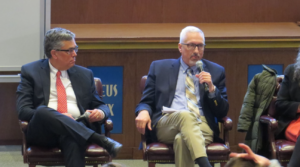An Update on the US Economy

Image Courtesy of France 24
By Chris Carey
A new fiscal year has stirred much political discussion surrounding economic indicators and policies, as well as new economic problems facing the nation such as international supply chain issues, inflation, and the job market.
Due to the 2020 coronavirus pandemic, international demand and supply dropped as consumers and suppliers alike focused on crisis management and shied away from increased production and consumption. Now, with more businesses reopening, consumers beginning to consider a return to semi-normalcy, and the rollout of mass vaccinations, the supply lines that functioned at reduced capacity for so long are under a strain that is too great to handle.
Reuters reports that a key port in California has contributed to these issues as it has ranked among the least efficient ports in the world in a recent study. This is just one example of the holdups in processing as well as production that have plagued the world economy and will continue contributing to increased prices and delays on goods as the holiday season approaches.
The strain has been felt around the globe. China, the UK, Germany, and the United States have all reported supply chain bottlenecks while consumer demand continues to increase. This has had an aggregate impact on pricing, with the prices of many household goods and food services rising throughout the globe.
Domestically, the Social Security Administration announced that payments for those collecting on the social welfare program will see a 5.9% increase in their monthly payments in a cost of living adjustment. These adjustments are expected to be enacted at the beginning of the 2022 calendar year and are a part of the Social Security Act’s provision for the cost of living increases.
This increase would mark the largest adjustment since the 1980s and will result in an average increase of $83 per check for beneficiaries. It is possible that some correlation between the rising prices due to inflation and the cost of living adjustment exists.
Also on the home front, Trading Economics focuses on increases in the inflation rate which reached a 13 year high of 5.4% in September of 2021. A recent paper published by the Federal Reserve of San Francisco attributed these inflation hikes to the Biden Administration’s economic policy initiative, CNN reports.
The American Rescue Plan, a stimulus package numbering $1.9 trillion, was made law in March, and the Federal Reserve of San Francisco found that the spikes in inflation rates in recent months can be attributed to this policy. The paper also concludes that although the policy has increased inflation in the short term, it is unlikely to cause a longer-term inflation shake-up.
The paper predicts that there will be a greater and more lasting effect on job markets, stating that the ratio of vacant positions to individuals unemployed will increase by .6 through 2021 and .5 in 2022 as a result of the Biden plan.
In all, the paper predicts that the Biden Administration’s spending in March will have an effect on the economy for the next one to two years before tapering off, and will not result in a marked increase in either the vacancy to unemployment ratio or in the inflation rates.
The Federal Reserve also predicts the United States’ greatest growth since the 1980s as the economy bounces back from the coronavirus pandemic. This immense growth in the country may result in price instability which is only exacerbated by the supply chain issues and inflation; however, it is expected that similar to the American Rescue Plan, the effects will not be particularly long-lasting.






